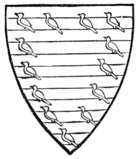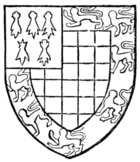in the fourth quarter a mullet gold"—the use of the term "gold" being alone permissible in such a case.
Any animal which needs to be described, also needs its position to be specified. It may be rampant, segreant, passant, statant, or trippant, as the case may be. It may also sometimes be necessary to specify its position upon the shield, but the terms peculiarly appropriated to specific animals will be given in the chapters in which these animals are dealt with.

Fig. 60.—Arms of Aymer de Valence, Earl of Pembroke: "Baruly argent and azure, an orle of martlets gules." (From his seal.)
With the exception of the chief, the quarter, the canton, the flaunch, and the bordure, an ordinary or sub-ordinary is always of greater importance, and therefore should be mentioned before any other charge, but in the cases alluded to the remainder of the shield is first blazoned, before attention is paid to these figures. Thus we should get: "Argent, a chevron between three mullets gules, on a chief of the last three crescents of the second;" or "Sable, a lion rampant between three fleurs-de-lis or, on a canton argent a mascle of the field;" or "Gules, two chevronels between three mullets pierced or, within a bordure engrailed argent charged with eight roses of the field." The arms in Fig. 61 are an interesting example of this point. They are those of John de Bretagne, Earl of Richmond (d. 1334), and would properly be blazoned: "Chequy or and azure, a bordure gules, charged with lions passant guardant or ('a bordure of England'), over all a canton (sometimes a quarter) ermine."

Fig. 61.—The arms of John de Bretagne, Earl of Richmond.
If two ordinaries or sub-ordinaries appear in the same field, certain discretion needs to be exercised, but the arms of Fitzwalter, for example, are as follows: "Or, a fess between two chevrons gules."
When charges are placed in a series following the direction of any ordinary they are said to be "in bend," "in chevron," or "in pale," as the case may be, and not only must their position on the shield as regards each other be specified, but their individual direction must also be noted.
A coat of arms in which three spears were placed side by side, but each erect, would be blazoned: "Gules, three tilting-spears palewise in fess;" but if the spears were placed horizontally, one above the other, they would be blazoned: "Three tilting-spears fesswise in pale,"
